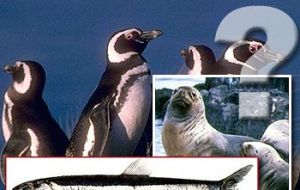MercoPress. South Atlantic News Agency
Argentine anchovy fishery may damage South Atlantic ecosystem
 Greater fishing pressures exerted on southern patagonian anchovy could harm the local ecosystem.
Greater fishing pressures exerted on southern patagonian anchovy could harm the local ecosystem. The indiscriminate Argentine anchovy (Engraulis anchoita) fishing in the southern zone of Argentina could inflict serious damage to Magallanic penguins, whales, seals and sea lions population numbers, warned a study published in prominent scientific magazine Science.
"Catching Argentine anchovy in excess could alter the energy flow in the Southwest Atlantic ecosystem, damage other sorts of fauna and affect ecotourism," says Elizabeth Skewgar, a scientist working for University of Washington's Department of Biology. Moreover, indiscriminate fishing could be detrimental to the recovery of common hake (Merluccius hubbsi), she adds. The study says that the growing demand of fishmeal could encourage an unsustainable expansion of the Argentinean anchovy commercial fishery along the Patagonian coast. Skewgar says that if authorities of the Argentine fishing sector wish to recover the common hake fishery and increase Argentine anchovy fishing activities, they should strive to properly understand how food interaction works among the different species there. "Changes in the Argentine anchovy population could alter abundance of predators and prey. A reduction in the population of one species could spread along throughout the food chain and change the energy flow and the abundance of species that are not directly linked to Argentine anchovy," the scientist explains. Three years ago, a plan presented by Chubut province to set in motion an experimental programme for common anchovy fishery (at that moment, considered an underexploited species) was approved by the Federal Fisheries Council (CFP). Skewgar says that, even if the plan considers the proximity of Peninsula Valdes as well as that of the greatest continental Magallanic penguin colony, in Punta Tombo, "it lacks the specific mechanisms to assess the effect of fishing on the fish and species dependent on Argentine anchovy" in that region. During December 2006, experts of the National Institute for Fisheries Research and Development (INIDEP) evaluated the state of Argentine anchovy in the area between parallels 41º S and 45º 20' S and inside the San Matías Gulf to estimate the biomass. According to provisional data provided by the Argentine Agriculture, Livestock, Fisheries and Food Secretariat (SAGPyA), from 1 January to 1 December 2006 30,940 anchovy tonnes landed at Argentinean ports (the annual amount for 2005 had been 34,403 tonnes). Last year, the Mar del Plata port (Buenos Aires) received 30,591.6 anchovy tonnes from 1 January to 30 November. Meanwhile, in the Madryn port (Chubut), 318.4 tonnes were landed and in the Rawson port (Chubut), only 30 tonnes. Most of the catches were made by a fresh fishing fleet, which landed 21,256.7 tonnes of anchovy according to SAGPyA statistics. The coastal fleet landed 9,498.8 tonnes; the inlet/ria vessels, 123.2 tonnes and the trawling fleet, 61.3 tonnes. (FIS)




Top Comments
Disclaimer & comment rulesCommenting for this story is now closed.
If you have a Facebook account, become a fan and comment on our Facebook Page!